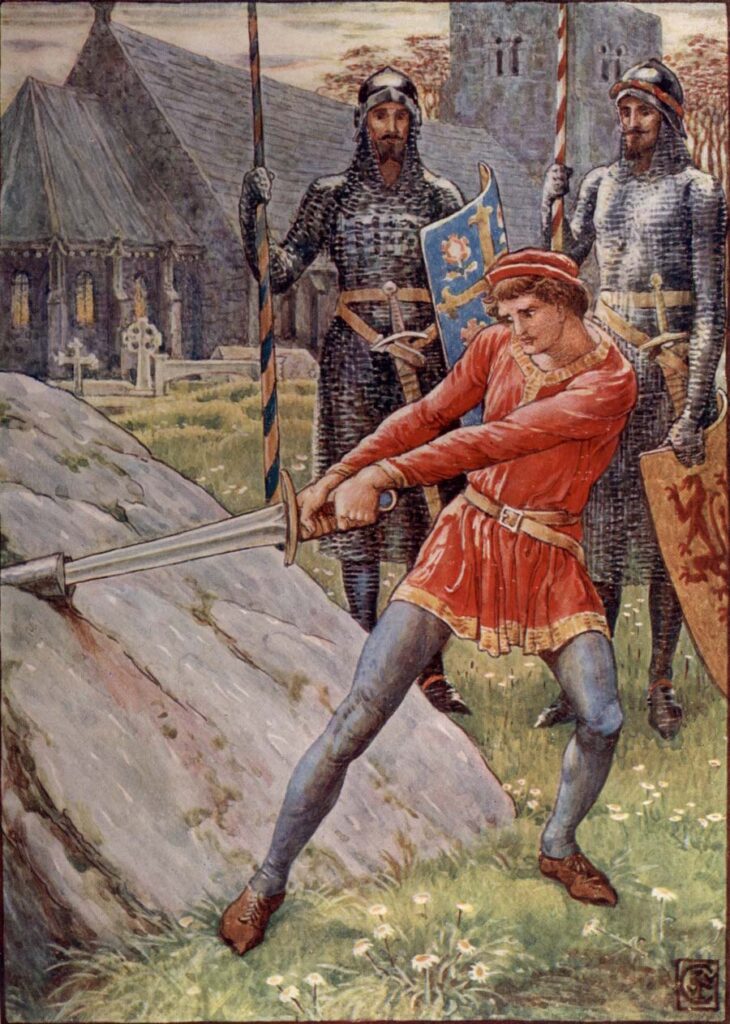One of the most famous elements of the Arthurian legend, the Sword in the Stone theme first appears in the prose redactions of Robert de Boron’s Merlin.

King Uther Pendragon having died, apparently without an heir, the British lords gathered in Logres or London at the behest of the Archbishop of Canterbury to discuss the appointment of a new king. As if by magic, an enormous stone appeared in a churchyard. The stone had an anvil on top of it, in which a magnificent sword was embedded.
This sword is identical to Excalibur in the prose versions of Merlin, but is a separate sword in the Post-Vulgate Suite du Merlin and in Malory.
A message on the pommel of the sword read:
Whoso pulleth this sword out of this stone and anvil is rightfully-born king of all England.

All knights present tried in vain to drawn the sword but it remained fixed in the stone despite their best efforts.
Arthur arrived in Logres as the squire of Kay, his foster-brother, who was attending his first tournament. Kay forgot his own sword at the first joust, and sent Arthur to retrieve it. Arthur, unable to find it, wandered into the churchyard and found the Sword in the Stone. With the intention of taking it as a substitute for Kay’s sword, Arthur drew it from the stone, unwittingly proving himself king of Britain.
He had to repeat the feat several times to satisfy the lords present. In the versions in which the Sword in the Stone is not Excalibur, Arthur wields it for a while but breaks it during a combat with King Pellinore.
Another Sword in the Stone appears during the Grail Quest. This sword was called the Adventurous Sword. It had once belonged to Sir Balin the Savage, having been given to him by a lady from Avalon. After Balin’s death, Merlin fitted it with a new pommel, shoved it into a block of marble, and floated it away on a river. At the beginning of the Grail Quest, it floated up to Camelot. The pommel read:
Never shall a man take me hence save only he by whose side I ought to hang, and he shall be the best knight of the world.
Lancelot, Gawain, and Perceval all tried to draw the sword without success. Galahad soon arrived and took the weapon, placing it in an empty scabbard he had brought for that purpose. Galahad later disposed of it in favor of the Sword with the Strange Hangings.
The Sword-in-the-Stone motif is a subset of a larger theme which includes any instance of a knight drawing a weapon from a fixture in order to prove his skill or nobility. In Perlesvaus, for instance, Lancelot has to pull a spear from a pillar to survive the Castle of (the) Griffins, and later must pull a bolt from a pillar in Arthur’s hall. In Meriadeuc, Meriadeuc displays his valor by unbuckling a sword from the waist of Lady Lore of Cardigan.
In Robert de Blois’s Beaudous, Beaudous, Gawaine’s son, proves his right to marry Beauté by drawing the sword Honoree from its sheath. Finally, in the Post-Vulgate Suite du Merlin, Balin proves his prowess by drawing a sword from a sheath carried by a lady from Avalon. This theme is prevalent in classical mythology and may ultimately originate in the Greek tale of Thesus, who proved his paternity by removing his father’s sword from under a stone.
Sources
Joseph d’Arimathie | Robert de Boron, 1191–1202
Prose Merlin | Early 13th century
Vulgate Merlin | 1220-1235
Post-Vulgate Suite du Merlin | 1230-1240
Le Morte Darthur | Sir Thomas Malory, 1469-1470
